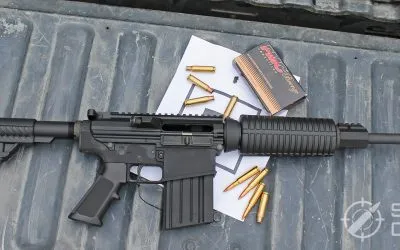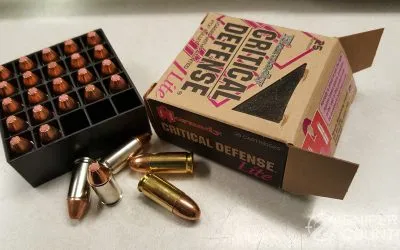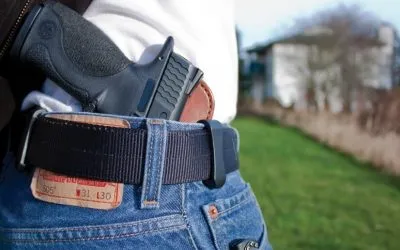Ruger and the revolver
First, before we get to the Ruger GP100, let's take a quick look at history.
Ruger has had a long relationship with revolvers. Although the company was founded to produce a semi-automatic .22 pistol, Ruger's second product was actually a single action revolver in .357 Magnum.
This was to capitalize on the cowboy craze of the 1950s on television and the big screen. “Cowboy guns” were very popular so Ruger jumped on that bandwagon and started producing a six-shooter called the Blackhawk in .357. This got the ball rolling.
Today, Ruger is the largest firearms manufacturer in the U.S. and a whole lot of those guns are revolvers.
Before we jump to the GP100, you may want to review Ruger’s history with the revolver in my review of the Wrangler .22 revolver here. It’s an interesting read about an interesting company.
The Security-Six, the GP100's predecessor
In 1972 Ruger introduced the Security-Six, a DA/SA revolver in .357 Magnum/.38 Special. You may also have heard of its variants, the Speed-Six and Service-Six.
This was back when police carried revolvers and those revolvers needed to be dependable. I remember when that Security-Six model (along with its variants listed above) came out. They were priced right, not fancy, and carried by many in security services, law enforcement and related fields - and not a few civilians. After a while, reports began filtering in about some of the guns not standing up to a steady diet of full-house .357 loads without “shooting loose” or otherwise needing a trip back to the factory.
Nevertheless, it was still a popular gun and was produced until 1988.

Photo credit to HandgunsMag.com.
BONUS OFFER: Get your free shooting range targets to print at home!
Get your free targets to print at home!
The GP100 was built to be tougher
In 1985, three years before the Security-Six was discontinued, the GP100 was introduced along with its stablemate the 5-shot SP101. Ruger had decided to replace the single Security Six model with two new ones with each specializing in its own purpose. The Ruger SP-101 was for concealed carry and the GP100 was for duty, hunting and competitions.
The GP100 was a gun purposefully built on a stronger frame - a .44 Magnum capable frame - so that it would be able to stand up to whatever was loaded into its cylinder. You will notice that it is a stronger unibody frame with no sideplate. To my knowledge, mission accomplished - the GP100 is arguably the toughest .357 Magnum revolver for its size out there.
Another strength factor is the cylinder lockup. The cylinder locks at three locations: the rear, bottom and front. They put the front lock on the crane so that it locks into the frame at the yoke. Most other designs lock at the rear and the bottom with a latch of sorts for the ejector rod to seat into - not a proper lock. Some other revolvers (Taurus comes to mind) will also lock the cylinder crane into the yoke but it is not common practice.
The GP100 is also fairly easy to take down with limited tools so you can keep it clean.

The GP100 Grip Frame
Additionally, the GP100 was redesigned the way in which the grip attaches. Ruger uses a short, rectangular extension that comes down off the bottom of the frame with a threaded hole at the end. This enables the gun to use one-piece grips unlike most other competing revolvers that have exposed metal backstraps and frontstraps. The Ruger frame allows just about any grip you would want to use.
If you wanted a roundbutt grip, it’s doable. Traditional revolvers would have to be built that way (abbreviated frame for the roundbutt grip) or have custom work done in order to change grip shape. That is a huge advantage. Ruger did not come up with that grip idea - Dan Wesson and High Standard beat them to it - but they ran with it and use it to this day.

GP100 Calibers
Calibers available for the GP100 include the .357 Magnum that we see here plus the .327 Federal Magnum, .38 Special, .22 Long Rifle, .44 Special, and 10mm Auto. All but the .44 Special use 6-shot cylinders, with the .44 in at 5. Additionally, seven-shot (.327 Fed. Magnum and .357 Magnum) and ten-shot (.22 LR) cylinders are used as well.
Counting distributor exclusives, there are 24 $829 Standard models available with four $969 Match Champion guns and two $1549 Super GP100s. That’s a lot of .357 (and other caliber) wheelguns.
More Ruger GP100 highlights: transfer bar and adjustable sights
The GP100 uses a transfer bar to transfer the energy of the hammer to the frame-mounted firing pin. This allows carry with all chambers loaded.
Also another area of interest is sights. There are several sight variations available for the GP100 from the factory. Want fixed sights? No problem. Need an adjustable rear? Got it, it’s standard. But what if you wanted to swap out your sights? There are a ton of aftermarket sights out there, plus at least one laser grip. The best part is that the front sight is so easy to change - press in on the plunger over the muzzle and remove the sight. (See photo below). Stick the new one in the slot and you’re good to go.

Why buy the Ruger GP100?
I guess I should ask “why not”? It is simply one of the strongest .357s out there. Plus, if you’re not a .357 fan, get it in one of the other calibers. At any rate, here are a few reasons to own one...
Personal defense
Are you a hiker? Ever walk through dangerous territory? I don’t just mean bear country, although that would be reason enough to carry something in this caliber. Of course, anywhere you go there’s always the threat of attack by individuals who want to make your stuff their stuff, or worse. Certainly, defense is another use.
Hunting
What about hunting? As you probably know, deer-sized game regularly are taken with the .357 Magnum. This gun would make a nice hunting companion to your rifle or shotgun. It is totally legal in my state for deer and other critters. Load it with shotshells for snake protection. Or, fill the cylinder with .38 Special wadcutters and hunt small game.
Competition
Competition pretty much goes without mentioning. There is a version of the GP100 called the Match Champion - guess where it got its name. Speaking of competition - check out the Super GP100 in 9mm. Wow.
My sons and I were talking and we agree that a 4-inch .357 Magnum revolver might just possibly be the one gun every shooter should own. Talk about versatility… there are many more reasons to own one that we’ve examined in our short time here. Likewise, I feel the same about a 4-inch .44 Magnum/Special. There’s just something - a mystique - about revolvers with this size barrel that screams “shoot me, please!” - they would be carried often around my environs.
Popular Articles
Photo Gallery










The Ruger GP100 At The Range
I went to my backyard range with exactly two loads to try as I set the targets up at 20 yards. Frustratingly, this ammo shortage is definitely having an effect on my ability to test several different loads through a gun in order to find one that shoots the best of the bunch.
Therefore, I had my tried and true handload of a cast Lee 160-grain tumble-lube SWC over 7.1 grains of Tite Group and the excellent .357 Magnum Hornady Critical Defense 125-grain JHP.
Both loads clustered most of their bullets together then stuck one up top and left - I found it interesting that both loads did that, not just one of them. I did not shoot any .38 Special loads through the gun. I figured that .38 ammo would work as it always does when I shoot it in a .357 revolver - it usually shoots very well.
Additionally, I wanted to know what the gun would feel like when I set off a full-tilt .357 load. It recoiled, obviously, but wasn’t too bad. Ideally, I would get a bullet mold for a .358 caliber, full wadcutter. I mention that here because that bullet could be the basis for a great practice load in the GP100. Moreover, I'd love to try one of those in my Taurus 85 or my S&W 638.
The top target is the handload - several bullet holes touching with one high-flyer. This load could be used for deer, as the velocity is usually around 1100+ f.p.s it is certainly accurate enough.
The second target is the Hornady load. Matter of fact, a shooter could get by pretty well with just these two .357 loads - one for self- or home-defense, and the other for hunting. Add in a mild .38 Special load for everyday practice and you’re good to go. This revolver seems really accurate despite the flyers - a definite plus.
For hunting, protection, target work or duty, the GP100 should do whatever you ask of it. I had never shot one, and I came away impressed.


Ruger GP100 specs
| Overall Length: | 9.50" |
|---|---|
| Weight: | 37.9 oz (weighed on my digital scale; Ruger says 40 oz.) |
| Grips: | Hogue® Monogrip® |
| Front Sight: | Replaceable Ramp |
| Barrel Length: | 4.20" |
| Trigger Pull Weight: | 10 lbs., 1 oz. DA; 4 lbs., 0 oz. SA (measured) |
| Material: | Stainless Steel |
| Capacity: | 6 |
| Rear Sight: | Adjustable for windage & elevation |
| Twist: | 1:18.75" RH |
| Finish: | Satin Stainless |
| Catalog: | KGP-141 |
| Features: | One-piece cylinder frame; triple-locking cylinder; grips easily changed |
| MSRP: | $829.00 |
| “Real-World” Price: | $700 - $900 (yup, some folks are charging more than MSRP) |
Where to buy the Ruger GP100?
At time of writing, the Ruger GP100 can be found brand new at Guns.com.
Which Ruger GP100 holster should you buy?
Well, luckily for you, we actually covered this in depth in our post 'The 4 Best Ruger GP100 Holsters' - check it out!
In summary
I said it above - a 4-inch .357 Magnum revolver is about as basic and useful a gun as you can get so every shooter should have one.
I remember reading in an issue of Shooting Times magazine back in the late ‘70s about how gun writer Skeeter Skelton (loved his articles and reviews) was in the desert with a lady who decided she wanted to take a cactus home. Maybe she wanted to decorate it - he didn’t say. With no saw or axe handy he went to Plan B - he used his 4-inch .357 to “cut” the cactus down. That is just about as close to a definition of a gun as a tool as I’ve ever seen and it illustrates the usefulness of the caliber and the revolver.
Semi-autos have their place, of course and I own several - I’m not a flat-earther - but somewhere in your gun collection there should reside at least one revolver. If that revolver is not a 4-inch .357, you need to go shopping. Once the king of police sidearms, now relegated (by many) to the odd range session or hunt, the 4-inch .357 carries with it a long and illustrious history. Heck, even Colt has re-issued its legendary Python in both 4.25- and 6-inch models… that says something about the popularity of such guns.
The Ruger GP100 is a proud member of that legacy and will continue to be one for many years. If you haven’t tried one, you need to… you might not only bring from the shooting session a renewed appreciation for old-school magnum revolvers, you just might also bring one of those revolvers home. If you own a GP100, let us hear from you below. As always, keep ‘em in the black and stay safe!
Not had enough? Check out our in-depth guide to the 12 best .357 Magnum revolvers!










![9mm Glock Models [Ultimate Guide]](https://snipercountry.com/wp-content/uploads/2018/10/Glock-17-vs-Glock-19-vs-Glock-26-vs-Glock-41-vs-Glock-43-WM-400x250.webp)
![Handgun Caliber Chart [2025 Ultimate Guide]](https://snipercountry.com/wp-content/uploads/2018/10/Handgun-Caliber-Comparison-400x250.webp)
![Rifle Calibers [Ultimate Guide]](https://snipercountry.com/wp-content/uploads/2018/12/Header-1900-400x250.webp)






